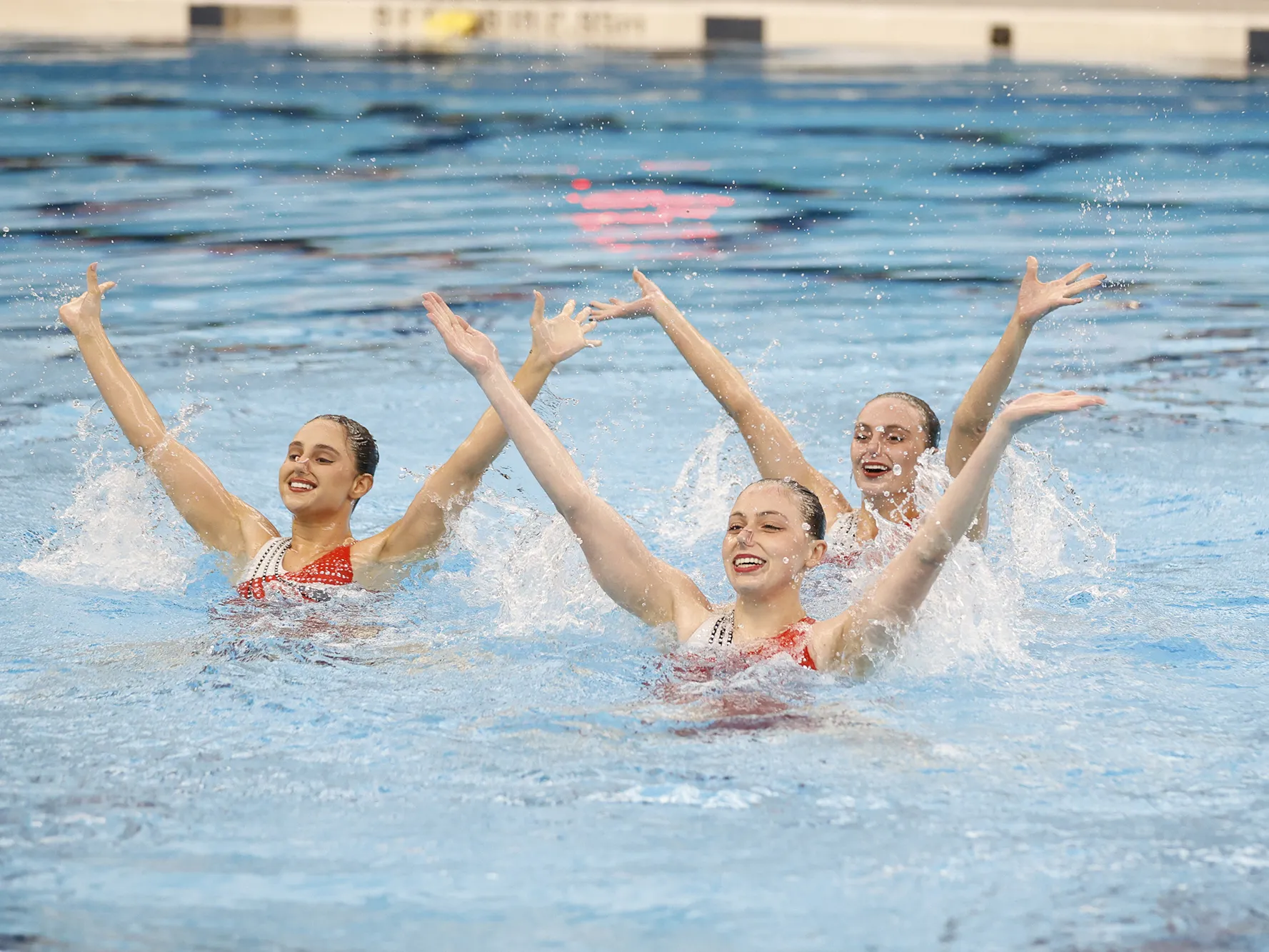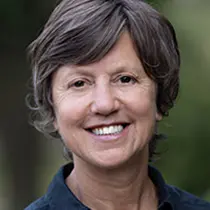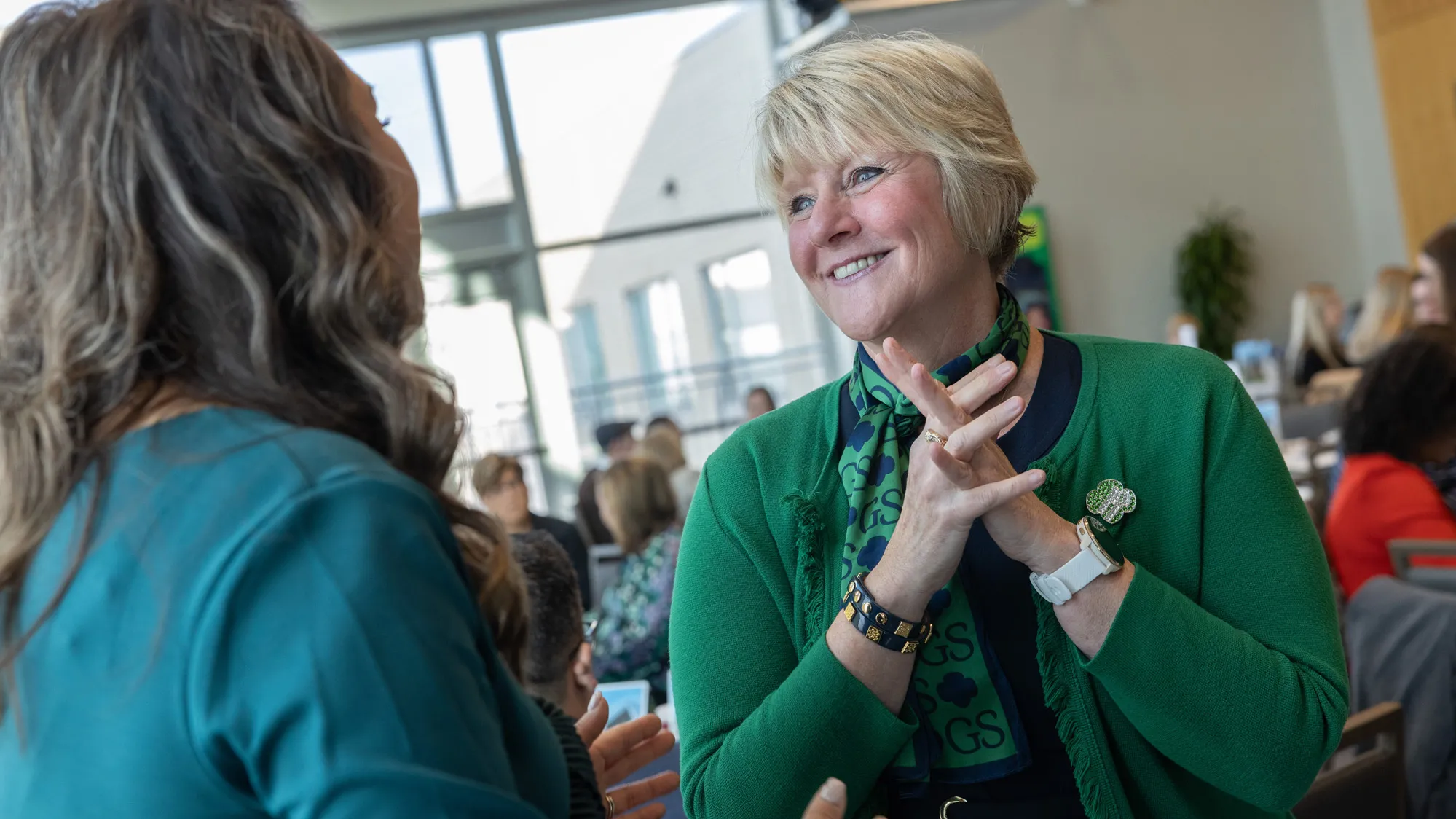
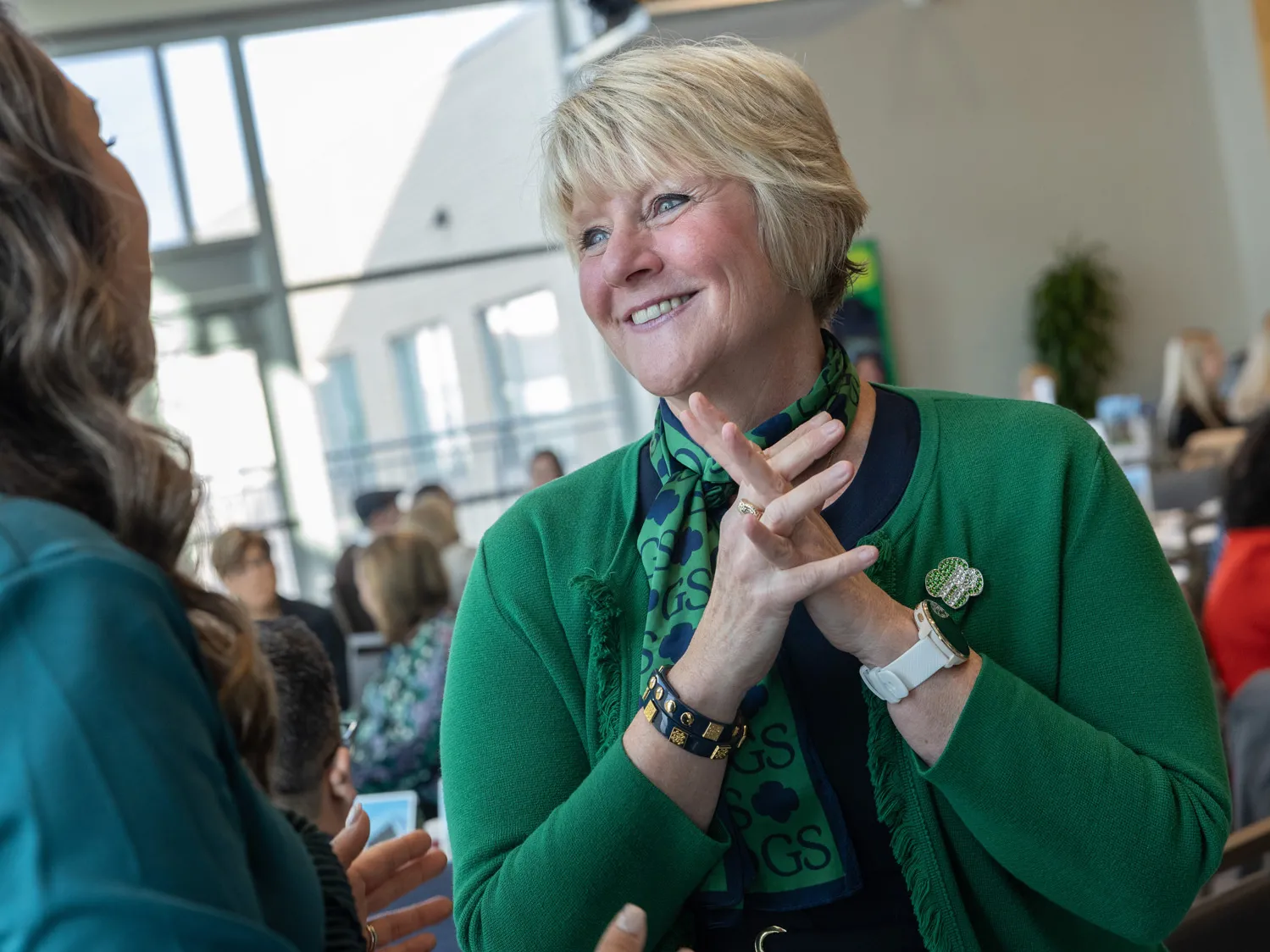
Tammy Wharton uses events such as her council’s annual State of the Girl conference to gather insights from community partners.
Amplifying girl power
Tammy Hunt Wharton ’91, who came to Ohio State for synchronized swimming, now leads Girl Scouts of Ohio’s Heartland.
Tammy Wharton uses events such as her council’s annual State of the Girl conference to gather insights from community partners.
Story by Ashley Rabinovitch | Photos by Jodi Miller
Today, as president and CEO, she is a passionate champion for girls and the driving force behind a new STEM campus that will equip them to strengthen Ohio’s workforce.
As a young Girl Scout, Tammy Hunt Wharton ’91 was all about the badges.
“I was absolutely covered in badges,” she says. “I had badges for first aid, cooking, pet care, camping — you name it. If I could master the skill well enough to get a badge and check it off the list, that is what made me happy in elementary school.”
Now, as president and CEO of Girl Scouts of Ohio’s Heartland, Wharton no longer focuses on the badges — she’s all about the girls she serves. In every girl who masters a new skill at day camp or sells those iconic cookies with her troop, Wharton sees a universe of potential. She sees herself, back before she embarked on her journey to lead.
In her hometown of York, Pennsylvania, Wharton spent her childhood in the swimming pool. There had to be somewhere for all that energy to go. With a tenacious spirit and fierce competitive streak, she retired from her local Girl Scout troop in fourth grade to devote herself to competitive synchronized swimming. Buoyed by a supportive, close-knit family and coaches who recognized her talent, she spent most of her waking hours developing the strength and artistry to compete at the highest level.
She arrived at Ohio State at 17 to join a team of champions.
“Ohio State’s record of putting individuals on the U.S. national team made it my first choice,” she says. “I was confident this was a place where I could excel in the pool and in the classroom.”
Wharton went from being a big fish in a small pool to having 19 peers who, like her, arrived on campus at the peak of their sport. The initial plunge into the world of Division I athletics was cold and daunting. True to form, she acclimated quickly. Over the next four years, she flipped, spun and propelled her way to the status of three-time U.S. national team member, four-time NCAA national champion and four-time All-American.
Her teammates remember her as an intense, focused competitor with a natural inclination for leadership. One, Tracy Moran ’91, says it’s no surprise she went on to lead a large organization.
“I knew Tammy from the time we competed against each other as kids in Pennsylvania,” she says, “so I have seen how driven and passionate she is by nature.”
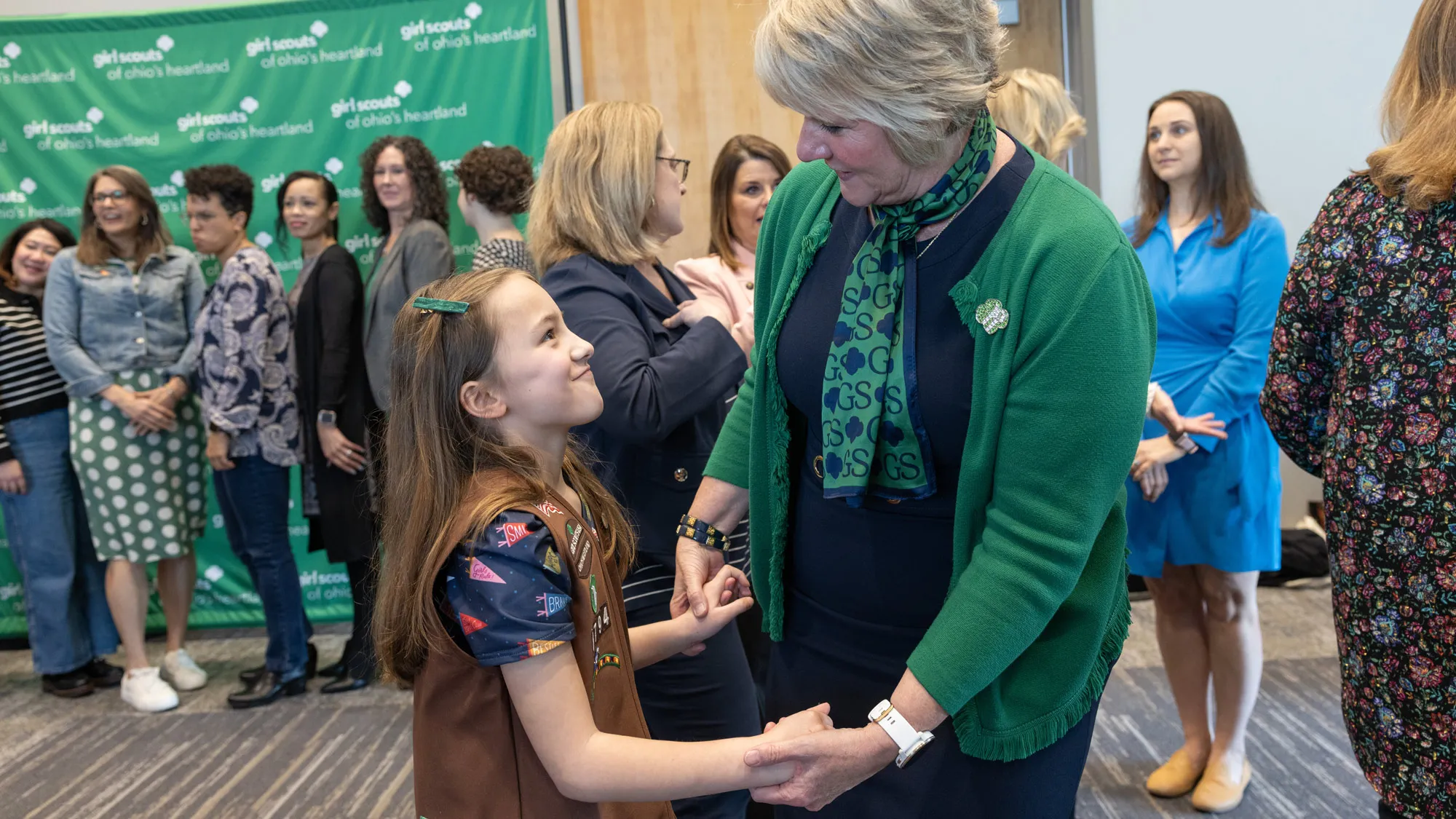
Brownie Chloe Jenkins greets Wharton at the State of the Girl annual meeting. Wharton was once just like Chloe — a young Girl Scout who loved earning badges and adventuring with her troop.
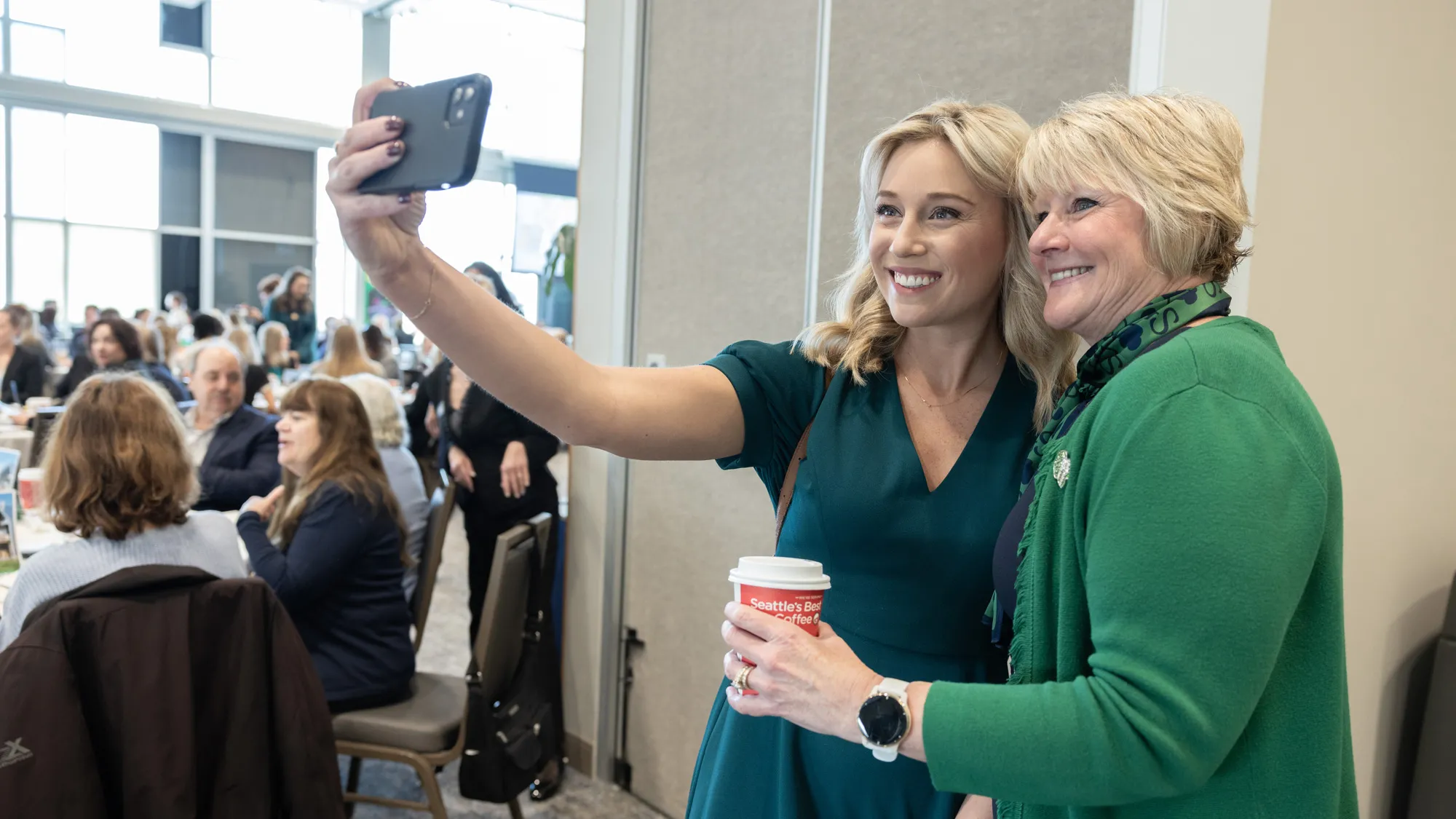
Wharton attributes her outgoing personality and fearlessness to invaluable mentors and her involvement in sports — including as a member of Ohio State’s synchronized swimming team. Here, she connects with Columbus reporter Kate Siefert.

At the annual State of the Girl community conversation, Wharton speaks to the group. She’s led Girl Scouts of Ohio’s Heartland since 2008 and one of her biggest achievements: raising about $14 million so far (toward a $16 million goal) to build their new STEM center.
In her fifth and final year at Ohio State, Wharton became an assistant coach, a role she tackled with gusto for two years after graduation.
She credits competitive swimming with teaching her the greatest lessons of her youth, from time management and teamwork to commitment and resilience. But by far the hardest lesson was how to respond when life’s most carefully choreographed routines fall flat.
After a dazzling run in collegiate and national synchronized swimming, Wharton saw as her natural progression helping those who came after her achieve success. From the first day she set foot on campus, her dream was to become a head coach. Two years into serving as an assistant coach, there was a vacancy. She didn’t get the job.
“It was one of those failures that changed the trajectory of my life,” she says. “Looking back, it was a blessing in disguise because I would not have experienced all that I’ve experienced since then. Life would be boring if it went according to plan.”
After leaving the team’s coaching staff, Wharton helped run Ohio State athletic camps for a summer before joining LifeCare Alliance, Columbus’ first in-home health care agency. With one foot in marketing and the other in fundraising, she learned how to craft and convey stories that made people take notice. When a fundraising position opened up at the Girl Scouts’ Seal of Ohio Council, she made the leap and reignited a formative relationship.
Like mint and chocolate, Wharton and the Girl Scouts were always a natural fit. A large body of research indicates girls learn best in an all-girl environment, something Wharton has known since childhood. Whether it was with her Girl Scout troop or her swimming teammates, she felt safe to explore, fail and learn alongside other girls.
Wharton grasps things best with the kinesthetic form of learning that Girl Scouts promotes. She was an intelligent, highly motivated student, but she struggled to focus in a traditional classroom setting. As a Girl Scout, she learned by doing and gained confidence in the process.
Twenty years later, she embraced the opportunity to help the next generation of girls build their confidence.
“After all the support I received as a young person — from family, coaches and so many others — it was my turn to pay back,” she says.
As the Seal of Ohio Council’s director of development, Wharton spoke eloquently and passionately in the public sphere about the work of Girl Scouts. She represented her organization for three years at community events, in media appearances and among donors, always with the aim of maximizing the resources available to the girls she served.
Wharton was in her element, but she wanted to call the shots for the larger organization. On the advice of a mentor, she went back to school to earn a master’s degree in nonprofit management.
With those credentials in hand, she accepted a new role as executive director of the Columbus Literacy Council, an agency geared toward expanding Central Ohioans’ employability and civic involvement. For the next two years, she took a crash course in leadership as she served as the agency’s chief strategist and ambassador. The experience made a profound impact, preparing her for her greatest challenge yet.
In 2008, three Girl Scout councils merged to form one larger entity: the Girl Scouts of Ohio’s Heartland Council.
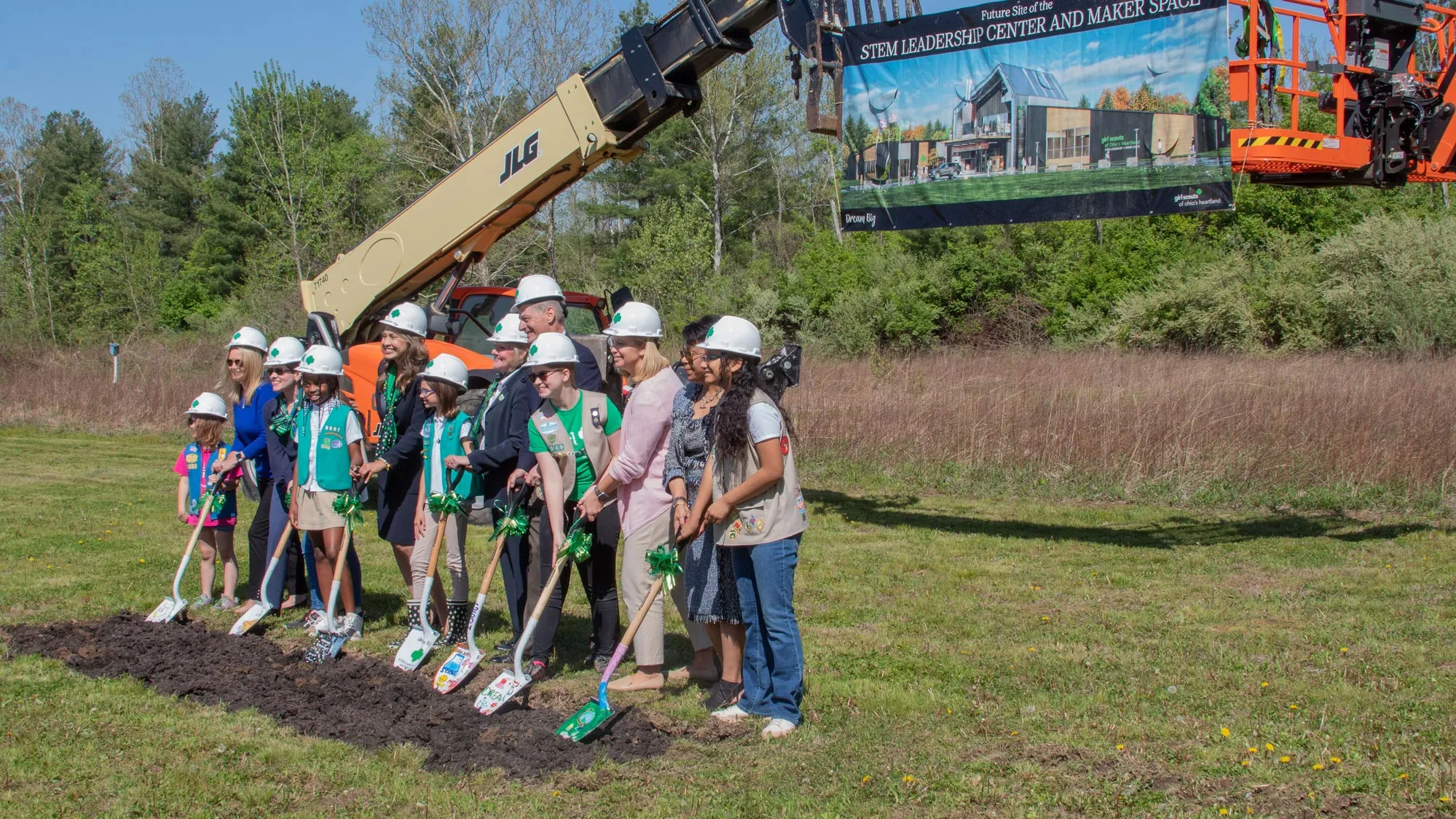
Girl Scouts and other leaders gather for the groundbreaking at the STEM center site. The organization has a membership of more than 15,000 girls in grades K-12 and 4,200 volunteer leaders. (Photo courtesy of Girl Scouts of Ohio’s Heartland)
“I was learning so much at Columbus Literacy Council, but my heart was in leadership development for women and girls,” she says.
After leading the complex merger, Wharton landed her dream role as the newly minted council’s president and CEO. Under her leadership, it has blossomed into a formidable force for good in 30 Ohio counties.
Every year, close to 80 staff members and 4,200 volunteers impact the lives of more than 15,000 Girl Scouts in grades K–12. From day camps and school outreach programs to cookie sales and community events, Girl Scouts leave their mark around the state.
Over the past 15 years, Wharton has grown in confidence, competence and leadership prowess alongside the girls she serves — and she does so with the same prodigious energy that catapulted her to athletic success at a young age.
For Wharton, a typical day begins at 4 a.m. with a long run or bike ride. Burned out on chilly pools after years of early-morning practice, she constantly seeks fresh opportunities to achieve personal bests. She often has a working breakfast with a public official or nonprofit leader before heading into the office for strategy and planning meetings. A good portion of Wharton’s day is spent diving into finances, membership trends and recent research to maximize what the council can accomplish on behalf of the communities it serves.
Whenever possible, she attends local Girl Scout gatherings to put names and faces to her day-to-day efforts. At signature events like the Tree Tappers Festival, which focuses on maple syrup production, or the Mad Mud Challenge, a day of navigating a muddy camp obstacle course, this natural extrovert shines in a crowd. She introduces herself simply as someone who works with the Girl Scouts, preferring to draw attention to the troop leaders and volunteers she considers the organization’s unsung heroes.
Wharton can speak animatedly about each of the Girl Scouts’ four pillars: outdoor skills, life skills, entrepreneurship and STEM. And in the past few years, that last one has moved to the forefront.
Since its founding in 1912, the national Girl Scouts organization has been ahead of its time. In an era when women in STEM were the exception not the norm, Girl Scouts were earning aerospace badges. In 2017, the national organization made a pledge to engage 2.5 million girls with STEM-related programming by 2025.
Nearly a decade later, the need for programs that encourage girls to pursue careers in STEM is even more acute. Though women make up nearly half of the U.S. workforce, they hold only 18% of STEM leadership roles, represent 15% of engineers and architects, and earn 12% of computer science degrees. As tech powerhouses such as Intel, Amazon and Google set up shop in Central Ohio, the demand for skilled workers with STEM backgrounds is outpacing the supply.
From Wharton’s perspective, the lack of women in high-paying, in-demand STEM fields is not only a loss of income and stability for them and their families — it’s a loss for their communities. She applauds efforts to expand access to higher education for girls and women, and she takes it upon herself to advocate for resources to tackle the problem upstream.
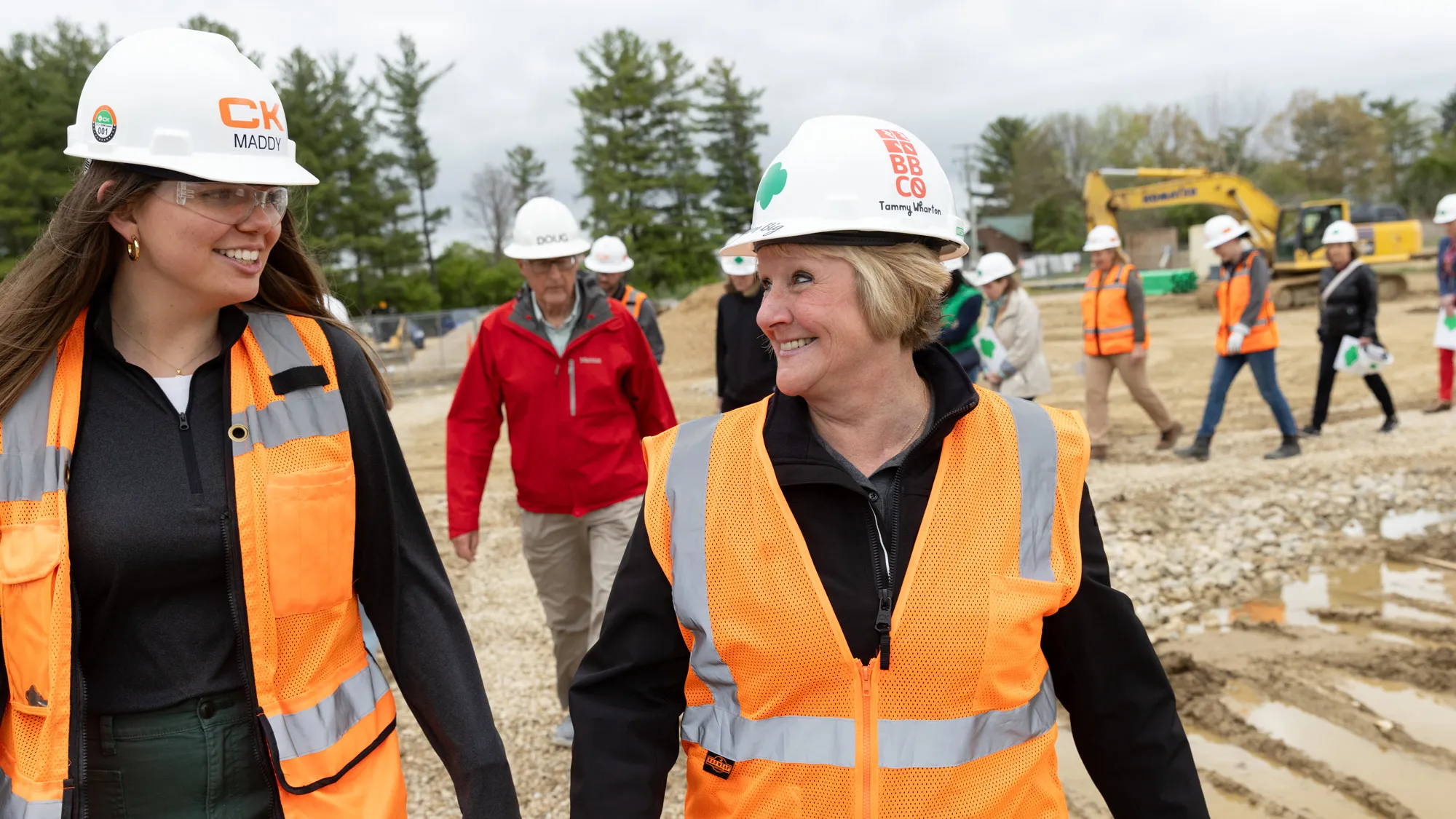
As she leads a tour of the construction site, Wharton chats with Maddy Brewer, project engineer with CK Construction.
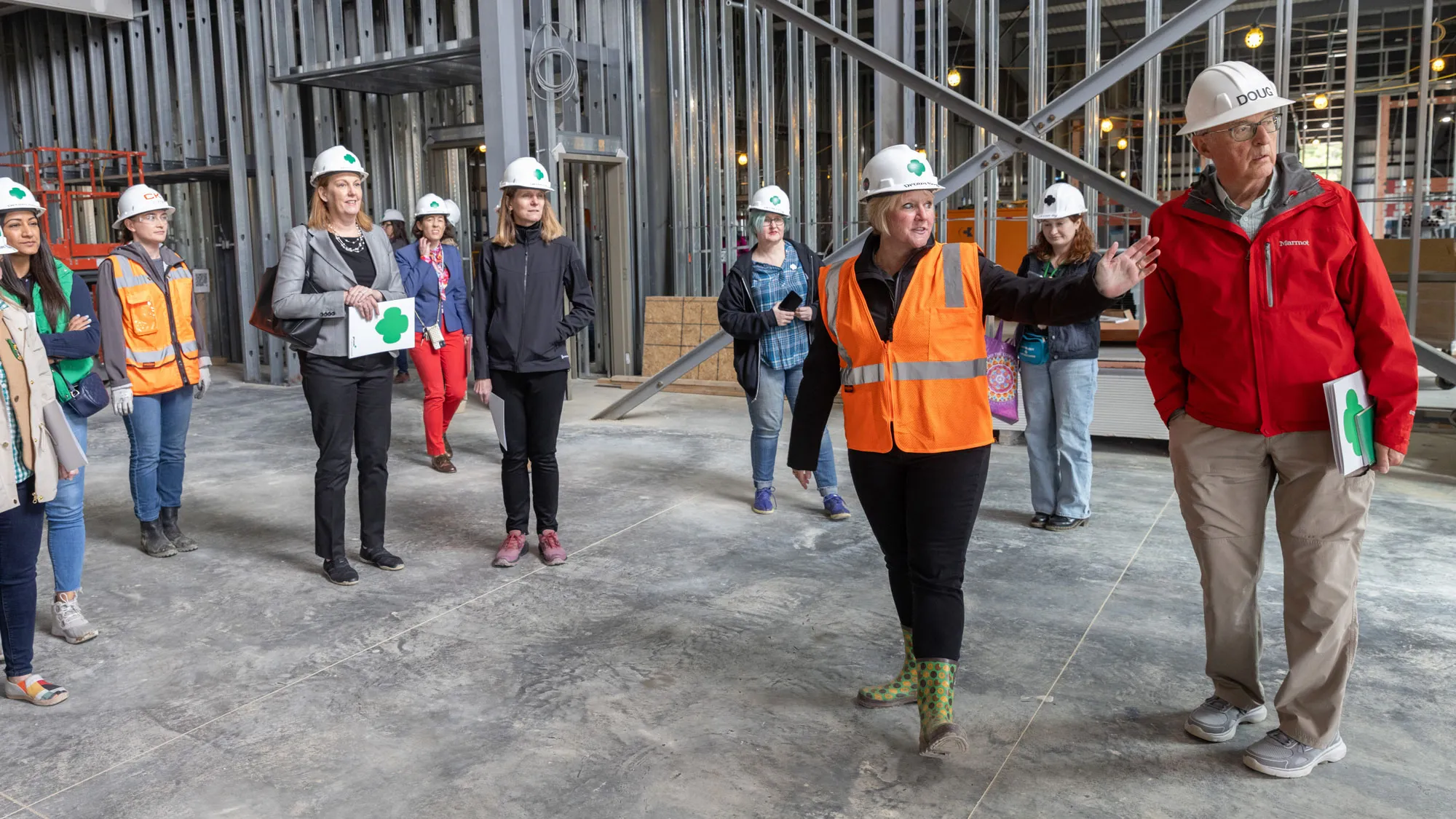
Garnering support for a new STEM Leadership Center and Maker Space, slated to open this fall in western Franklin County, is a major focus for Wharton these days. Here she walks potential donors through the facility.
“What most people don’t realize is that girls form a STEM identity by third grade,” Wharton says. “If they are not engaged and confident in STEM skills by then, they are much less likely to pursue a STEM-related career in the future.”
As leader of Girl Scouts of Ohio’s Heartland, Wharton has always known she has a role to play in encouraging girls to consider career paths not previously on their radar. In her experience, one key to sparking a love of STEM is helping girls recognize that they are already learning these disciplines’ principles in their Girl Scouting activities.
At Girl Scout camps such as Camp Ken-Jockety, a scenic getaway 14 miles west of downtown Columbus, STEM is everywhere you look. When campers compete in a regatta, working together to build a cardboard boat that will carry them across a pond, they learn physics. When they take part in the camp’s maple syrup program, which emphasizes that it takes 40 gallons of sap to make a gallon of maple syrup, they sharpen their math skills. When they play a bamboo instrument in the music garden, they consider the science of sound.
Fiercely committed to the concept that “if you can see it, you can be it,” Wharton and her team routinely invite engineers, architects, ecologists and other professionals, particularly in STEM fields, to speak to groups of Girl Scouts about their jobs and lead hands-on activities. Whether it is a day spent on campus with Ohio State’s Society of Women Engineers or a visit from a logistics expert at a transportation company, each experience expands the horizon of possibility.
“One of the unique things about Ohio State is that there are so many areas of study, but even as a student, I didn’t know what half of them were,” Wharton says. Similarly, elementary, middle and high school students have limited exposure to most career paths unless someone takes the time to show them something new.
This investment has clearly paid off — more than 86% of Girl Scouts in the council’s region reported interest in STEM careers — but good has never been good enough for Wharton. After joining the national STEM pledge in 2018, she and her team flew to Texas to tour an immersive STEM campus a sister council had recently opened.
“It was amazing, but we decided we could create something even bigger and better,” Wharton says. “That is the Buckeye spirit in us.”
For the next year, she embarked on an exploratory journey to discover who was making strides in STEM education and how Girl Scouts could partner with them to multiply their efforts. Soon a vision for a new immersive campus on the grounds of Camp Ken-Jockety emerged.
The Heartland council’s STEM Leadership Center and Maker Space, scheduled to open this fall, will elevate STEM education for girls beyond anything Central Ohio has ever seen.
Girls will have dedicated space to develop skills in areas such as automotive technology and robotics. They will learn the basics of water quality testing using samples from Big Darby Creek and try their hand at hydroponics and urban gardening in a new greenhouse. At the entrance of the new campus, a gleaming leadership center will accommodate up to 300 people for corporate events, volunteer meetings and indoor programming in space, science and technology labs.

Wharton and Brynn Albert (right) work with Girl Scouts (from left) Carly Grubb and Sophia Costell during Pollinator Palooza at Camp Ken-Jockety in Galloway, Ohio. The drone is used to show how pollen is spread by bees and other insects.
Wharton and her team aim to welcome 20,000 to 30,000 Girl Scouts and visitors to the campus annually.
Cyndi White ’93 DDS, an area dentist and longtime troop leader, has watched the new campus rise from the ground.
“This will be a huge draw not just for Girl Scouts but for the greater community,” she says. “We are all excited to see people from different disciplines come together to give girls a chance to experience things they have never experienced before.”
Wharton has led the charge to bring the project to life through an initiative called Dream Big, which includes fundraising for the new campus.
“It takes tenacity to go out and meet with 100 people, knowing that 90 of them will be polite and turn you down,” says Lou Von Thaer, CEO of Battelle Memorial Institute, a key partner in making Dream Big a reality.
At Battelle, Von Thaer has a front-row seat to the transformation happening in areas such as cybersecurity and artificial intelligence. He also has the perspective that serving as a member of Ohio State’s Board of Trustees provides.
“Nationwide, we don’t have enough engineers and scientists to compete at a global scale,” he says. “Changing our workforce starts with sparking curiosity in the kids in our community.”
Dream Big has captured the attention of other influential leaders in Central Ohio, too.
Yvette McGee Brown ’85 JD, a prominent attorney and former justice of the Ohio Supreme Court, was one of the first people Wharton recruited to support the initiative. A member of Wharton’s “kitchen cabinet” since her early days at Girl Scouts of Ohio’s Heartland, McGee Brown has paid forward the benefits she received as a young Girl Scout in Columbus. She speaks passionately about the power of representation for girls from under-resourced communities.
“If you grow up in an area where no one who looks like you is an engineer or a physician or a lawyer, you don’t grow those dreams for yourself,” says McGee Brown. “But if you can see it, you can believe it’s possible.”
While she was immediately sold on the idea of a space where girls could explore STEM and learn from women in such fields, McGee Brown wondered if a project as ambitious as Dream Big could succeed. Over time, though, she has watched Wharton lead with “sheer shoe leather and determination” as she raises support.
“She has been relentless, knocking on countless doors,” McGee Brown says. “She’s become one of those people you can’t say no to.”
Elizabeth Seely ’90 MHA, chief administrative officer for the hospital division of The Ohio State University Wexner Medical Center, describes Wharton in similar terms, calling her “bold, determined and strategic at deploying people’s time, skills and talents.” As a third-generation Girl Scout, longtime troop leader and member of the Girl Scouts of Ohio’s Heartland Board of Directors, Seely is deeply invested in the success of Dream Big. As a health care executive, she knows how high the stakes are.
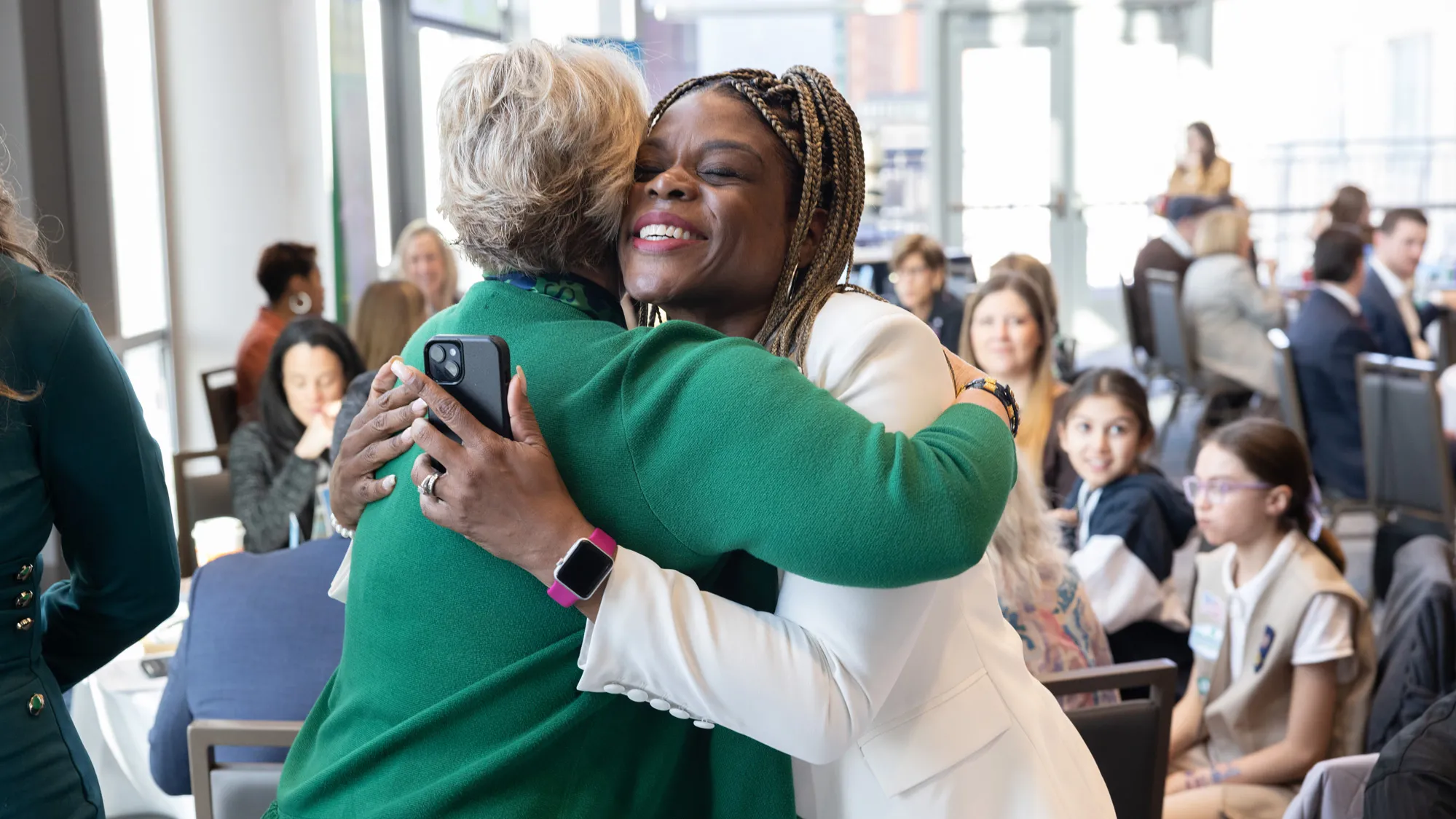
Wharton connects with volunteer Natasha Davis, whose daughter Jasmine is a Girl Scout, at State of the Girl, Girl Scouts of Ohio’s Heartland’s annual community conversation. Among other attendees was the CEO of Girl Scouts of the USA, Bonnie Barczykowski.
“Here in Central Ohio, we are projecting extraordinary population growth over the next 10 years,” she says. “In health care alone, we don’t just need more physicians and nurses. We need more respiratory therapists, infection preventionists, lab and imaging technologists — the list goes on and on. We need to inspire the next generation to fill these gaps, and we need to start young.”
Wharton has spearheaded the effort to raise $13.9 million of the $16 million needed to create the STEM campus, and she shows no signs of losing steam. As she forges onward, rallying the community around her vision, she draws upon the grit and tenacity reinforced in her as a Buckeye.
“Ohio State put its faith in me, both in the swimming pool and the classroom, and that has made all the difference,” she says. “In so many ways, it opened up the world to me.”
Now, Wharton is opening up the world to a new generation of girls, empowering them to dream bigger and reach higher than they ever imagined.
Want more STEM?
Check out the STEAM Factory in Columbus’ Franklinton neighborhood. Powered by Ohio State faculty representing many disciplines, this collaborative shares research, resources and fun. Watch the events page for good times to drop by.
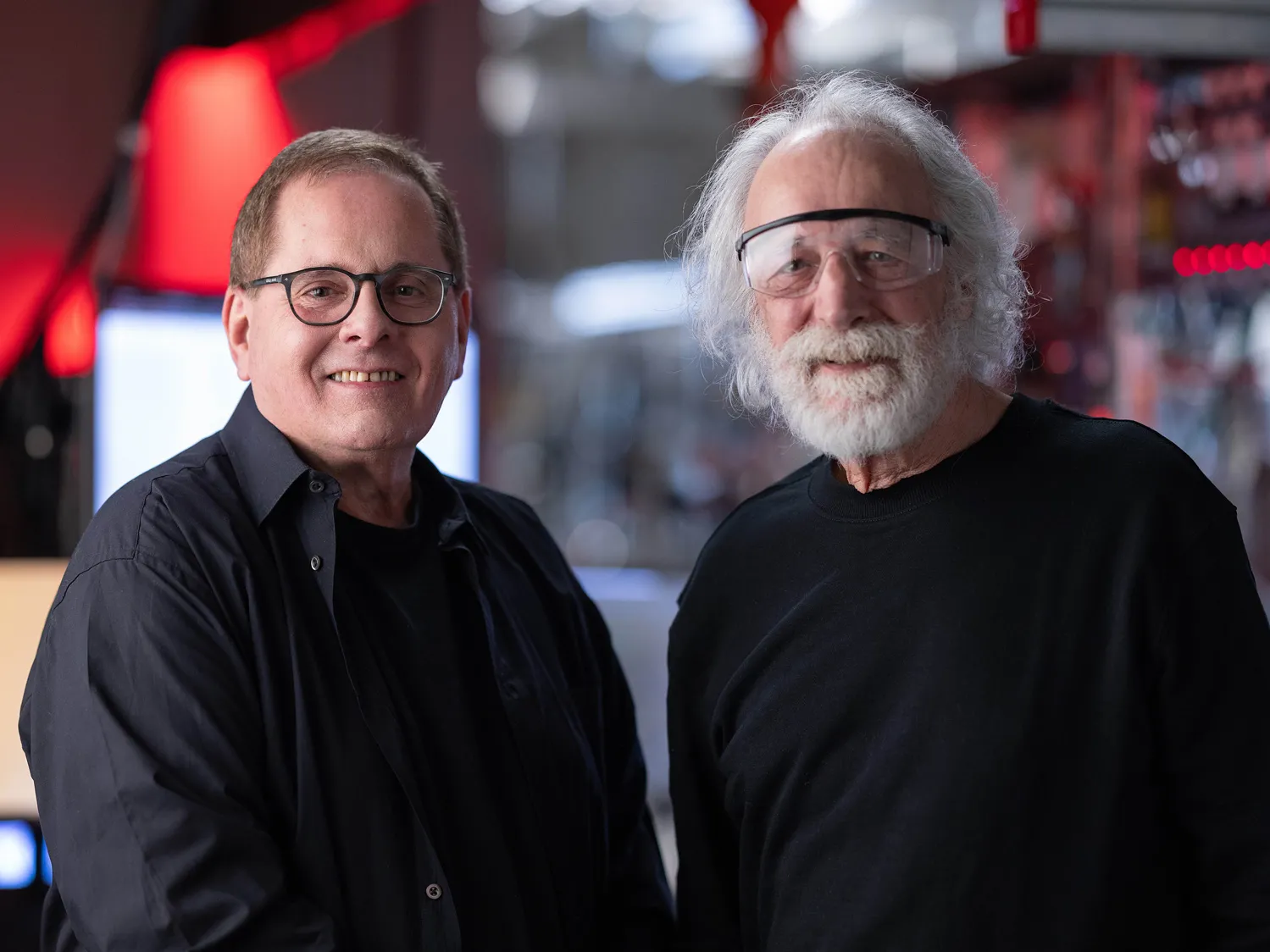
Professors Lou DiMauro and Pierre Agostini, a 2023 Nobel laureate, are developing the next generation of big thinkers.

In a totally unscientific study, we analyzed answers from 360 graduates to find out which 10 challenging courses were the most-cited.

Katie Paulson Silcott ’02, ’10 MA shares with middle schoolers the power of music to build confidence and unite people.
